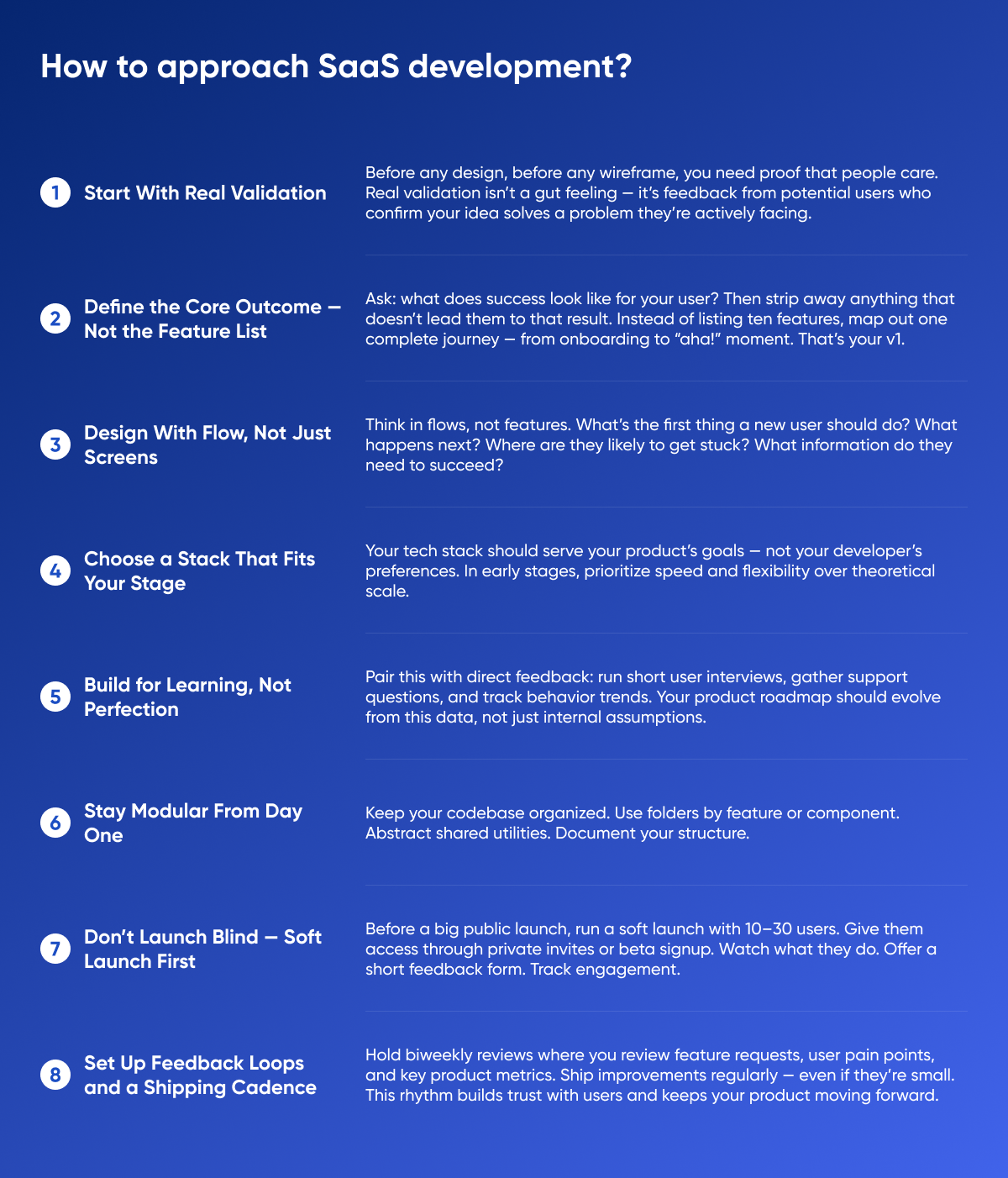You’ve got a problem worth solving and a vision for how your software could change the game. But between your idea and a live SaaS product lies a gauntlet of decisions — from architecture and UX to timelines and tech stacks. The way you move through those early stages determines more than your product quality. It sets the tone for your entire company.
At Movadex, we’ve helped dozens of SaaS startups build products from scratch — and we’ve learned that while every product is different, the process that leads to successful launches often follows the same best practices.
Here’s how to approach SaaS development with clarity, speed, and long-term scalability in mind.

Start With Real Validation
Before any design, before any wireframe, you need proof that people care. Real validation isn’t a gut feeling — it’s feedback from potential users who confirm your idea solves a problem they’re actively facing.
Speak with 15–20 potential customers. Ask about their workflows. Find out what tools they use and what frustrates them. Don't pitch. Listen.
If your interviews echo the same themes and pain points, you’re onto something. If not, pivot early. It’s much cheaper to test a concept in conversation than in code.
Define the Core Outcome — Not the Feature List
SaaS success doesn’t start with building more. It starts with building better around a focused outcome.
Ask: what does success look like for your user? Then strip away anything that doesn’t lead them to that result. Instead of listing ten features, map out one complete journey — from onboarding to “aha!” moment. That’s your v1.
Great SaaS products do one thing extremely well before they expand. Clarity here keeps your team aligned and your build lean.
Design With Flow, Not Just Screens
Design isn’t about how your product looks. It’s about how it feels to use.
Think in flows, not features. What’s the first thing a new user should do? What happens next? Where are they likely to get stuck? What information do they need to succeed?
Sketch user journeys before you touch high-fidelity UI. Use Figma or Whimsical to map flows and click through early prototypes. Test with real people, not just your team.
This step alone can save weeks of future rework and give your devs a clear roadmap.
Choose a Stack That Fits Your Stage
Your tech stack should serve your product’s goals — not your developer’s preferences. In early stages, prioritize speed and flexibility over theoretical scale.
React (for web), Flutter (for cross-platform mobile), Node.js or Django (for backend), and Firebase or Supabase (for real-time backend) are modern, founder-friendly stacks that scale well without overcomplication.
Pick tools with great documentation and strong community support. The best tech decisions are the ones your team can execute well and iterate on fast.
Build for Learning, Not Perfection
The goal of v1 isn’t to impress — it’s to learn.
Instrument your product with tools like Mixpanel, Amplitude, or Firebase Analytics. Understand what users click, where they drop off, and which features drive engagement.
Pair this with direct feedback: run short user interviews, gather support questions, and track behavior trends. Your product roadmap should evolve from this data, not just internal assumptions.
Stay Modular From Day One
You don’t need enterprise architecture at launch — but you do need clean separation between layers: UI, logic, API, and data.
Keep your codebase organized. Use folders by feature or component. Abstract shared utilities. Document your structure.
This makes collaboration easier, onboarding faster, and scale possible. Trust us: you’ll thank yourself in six months.
Don’t Launch Blind — Soft Launch First
Before a big public launch, run a soft launch with 10–30 users. Give them access through private invites or beta signup. Watch what they do. Offer a short feedback form. Track engagement.
This will uncover bugs, friction points, and unmet expectations — before they become public problems. Iterate fast, fix what matters, and scale what works.
Set Up Feedback Loops and a Shipping Cadence
SaaS lives and dies by iteration. After launch, your team needs a system for gathering feedback and acting on it.
Hold biweekly reviews where you review feature requests, user pain points, and key product metrics. Ship improvements regularly — even if they’re small. This rhythm builds trust with users and keeps your product moving forward.
Final Thought: SaaS is a Process, Not a Launch Event
Your product is never “done.” It’s a system that improves with every insight, every sprint, every user win. The best SaaS founders know this — and they build not just for delivery, but for evolution.
Whether you’re validating your first idea or scaling your first customer base, your biggest advantage is how fast and how clearly you learn.
At Movadex, we partner with startups to turn product thinking into real software — lean, scalable, and built for the long game. If you’re ready to build something users stick with, let’s make sure you start right.




